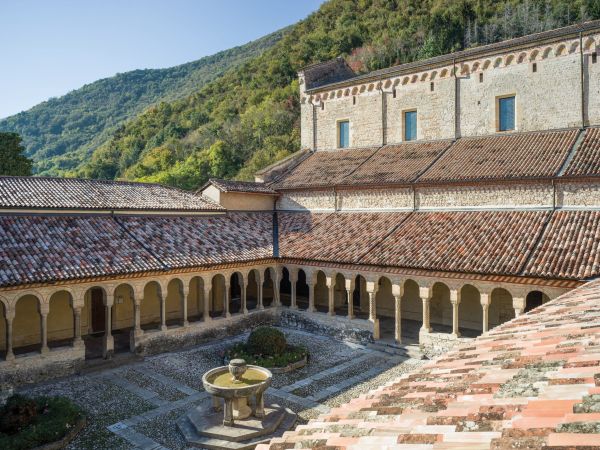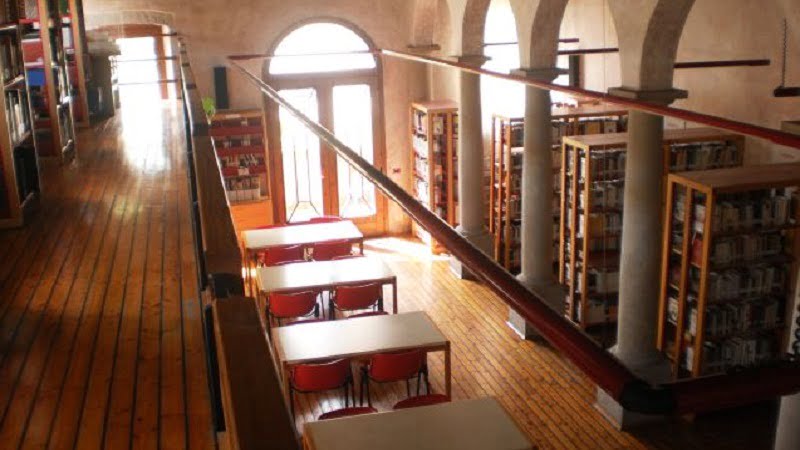


The Abbey of Santa Maria, also known as Sanavalle (Sanavallis), was a Cistercian monastery, now the seat of the parish of Follina, in the province of Treviso. It has the title of minor basilica.

The first mention of the abbey was found in a document dated 1127, attesting to the sale by the abbot Bernardo di Follina to a certain Arpone of three fields. The parchment was transcribed in the 17th century and the copy is now kept in the Municipal Library of Treviso.

A monastic complex therefore existed well before the arrival of the Cistercians, in the mid-twelfth century. It was most likely a Benedictine monastery dependent on San Fermo di Verona, where an ancient statue of the Madonna was venerated.

It is not clear when and how the transition to the Cistercian order took place. Some sources claim that the Benedictines changed monastic rule, but according to others, more likely, they were replaced by a new community. Consequently, the link with the Veronese abbey began to weaken: significant is a document of 1217 in which Pope Honorius III resolved a dispute with San Fermo in favor of Follina, in which the former refused a payment to the latter, claiming its independence from more forty years.

The traditional date of foundation, the year 1146, is not actually supported by historical sources. The Annales Camaldulenses themselves affirm that it is impossible to determine its origins, concluding that towards the middle of the 12th century the Benedictine abbey of Follina became Cistercian. It seems plausible that the community was called by Sofia di Colfosco, wife of Guecellone II da Camino, who in fact drew up a will in 1170 with which she made rich donations to the monastery.

Certainly Follina was linked for a long time by the abbeys of Chiaravalle and Cîteaux, the most important Cistercian centers of Italy and Europe respectively.

Over time the abbey was enriched with other donations, reaching the peak of its splendor in the thirteenth century. In 1124 Gabriele da Camino left the castle of Cison and the castle of Soligo; in 1229 Pope Gregory IX subdued to him the Hospital of Santa Maria di Piave and then the monastery of Santa Margherita di Torcello; in 1324 the monastery of Santi Gervasio e Protasio di Belluno was added. At the same time the complex was enlarged: in 1268 the cloister was built, while between 1305 and 1335 the basilica was built.

Starting from 1388 the abbey passed to the Serenissima. During its expansion policy, Venice clashed several times with the Sforza and Viscontis and with the Kingdom of France, in whose territories were Chiaravalle and Cîteaux, on which Follina depended. Seeing therefore the monastic institution with distrust, in 1448 the government asked Pope Niccolò V to suppress it.

The abbey was thus reduced to a commandery. Among the commendatory abbots there are some illustrious personalities, such as Pietro Barbo, future Pope Paul II, and Carlo Borromeo, who entrusted the administration of the assets first to the Dominicans, then to the Benedictines. In 1573 the commandment passed to Tolomeo Gallio, who entrusted it to the Camaldolese. The latter settled there permanently in 1739, but in 1771 the Republic of Venice suppressed the monastery, transferring its assets to San Michele di Murano and transforming the church into a curacy. The buildings of the complex, with the exception of the church and the sacristy, were sold to private individuals, which caused serious architectural disfigurement.

From 1807, after the Napoleonic suppressions, the assets were guarded by Don Bonifacio Baseggio, formerly a Camaldolese monk of San Michele. The basilica, left by the latter in 1819, to the municipality of Follina, was erected as a parish the following year by the bishop of Ceneda Giovanni Benedetto Falier, another Camaldolese from Murano.

In 1834 the monastery was ceded to the parish by the Gera di Conegliano counts.
The Servants of Mary have resided there since 1915. During the great war the church suffered serious damage which was compensated for with the restorations begun in 1919.

In 1921 Cardinal Pietro La Fontaine crowned the statue of the Madonna, while Pope Benedict XV declared the church a minor basilica.
In 2015 the community of Follina celebrates the centenary presence of the Servants of Mary and, with the transfer of the mortal remains of Father Anacleto Milani inside the basilica, remembers his work as the first Servant of Mary parish priest and as mayor during the Austrian occupation - Hungarian of the First World War.

On 12 May 2018, the Abbey celebrates the 750 years of the Cloister's construction with the Dante event in Follina in which the Odhecaton ensemble performs the premiere of Canto XXXIII del Paradiso composed by Mirco De Stefani.

Works
Inside the basilica, the following valuable works are worth mentioning:
- The large wooden altarpiece in neo-Gothic style built by Venetian craftsmen in 1921, a perfect copy of the original ancona present in the church of S. Zaccaria in Venice. It houses the sandstone statue of the Madonna del Sacro Calice that some suppose of Nubian origins from the sixth century. , which has always been the object of veneration and pilgrimage by the people of Follino and by the thousands of faithful from all over Italy
- The fresco "Madonna with Child and Saints" of 1527 by Francesco da Milano
- A remarkable wooden crucifix from the Baroque period (Camaldolese period) by an unknown author.
- The splendid cloister, older than the basilica and perfectly preserved in the elegant effect of movement created by the columns that constitute it, was completed in 1268, as evidenced by the stone engraving placed on the northern part of the cloister itself.
- From the intersection of the central nave with the right transept, the beautiful square-plan Romanesque bell tower rises, the oldest building present in the architectural complex of the abbey.
- The elegant Cloister of the Abbot and Loggia of the sixteenth century.

Visiting hours
The Abbey of Follina can be visited every day at the following times:
from 7:00 to 12:00 and from 14:30 to 19:00
It is not allowed to enter the basilica with visiting groups during the performance of religious services.
The Abbey of Cistercian Santa Maria of Follina
Address: Via Pallade, 31051
Phone: +390438970231
Site:
https://www.comune.follina.tv.it/home/Vivere/Abbazia-Cistercense.htmlLocation inserted by
CHO.earth